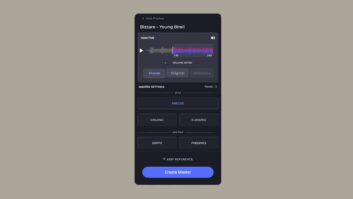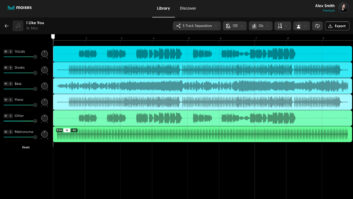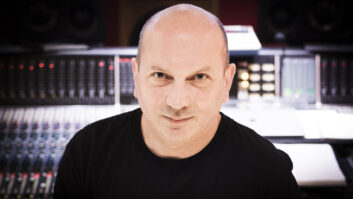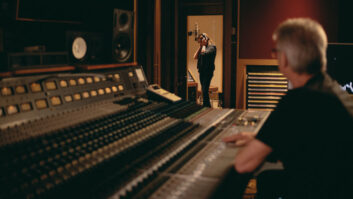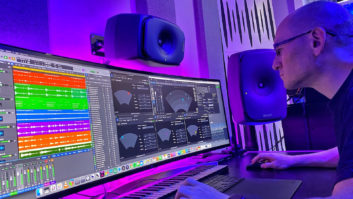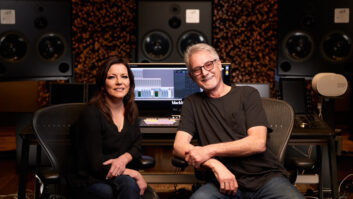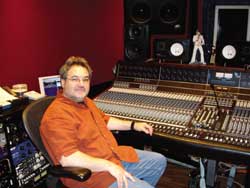
RICHARD DODD’S GEAR PEAVES
- Fader automation other than Flying Faders.
- The latest (re-issue) of the “greatest” gear (in most cases, although the Universal Audio LA-2A is great).
- Bad and often good performances made “vanilla” using pitch-correction plug-ins or timing fixes.
- Bad recordings of a good performance.
- Too much “stuff” in the signal path.
- Studio designers who don’t use studios.
- Body getting old, passion still 18.
Richard Dodd
WORK ON WILBURYS, HARRISON ALBUMS
I first became familiar with your work on the Wilburys and Harrison albums, those were both entirely analog? How many tracks? How many drum tracks?
George’s Cloud Ninewas recorded 24 tracks on a Studer A80 (snowplough) narrow-body tape machine with Dolby NR. Drums tracked with full kits, up to three players simultaneously live in a semi-circle (Ringo Starr, Jim Keltner and Ray Cooper). Most tracks were one player overdubbed and a couple were one person hitting a single drum, sometimes sampled. “Got My Mind Set on You” was Jim Keltner playing an un-quantized 4-bar loop into a Drumulator that carried samples we took from a kit Jim played in New York City. The source media for the samples was a cassette recording, true, with a little “timed” slap and (manual) Mute button during the final mix for the part variation. The drum machine and emulator 2 piano were meant to serve as guide tracks; however, they were never replaced.
In a way, using samples from cassette was the perfect accidental solution for those early digital devices. You’ve got extra tape saturation and plenty of noise for dither!
All of the mixes were performed manually on GH’s console (pre’s and EQ were built by Cadac), which had older-style Quadrant faders, 24-channel monitor section with EQ and aux sends (rare for a “split”-console design, especially one dating very early ’70s). I should point out that while none of the Cadac parts of the console were terrible, the stepped pan pots had only five positions (who needs more, eh?), dreadful 2-mix crosstalk and a split ¼-inch patchbay, half on each end of the console just to maintain visual symmetry. This system required the operator to use more cables to complete a patch chain on bays that were never used on a daily basis, and to my knowledge only ever cleaned (during the periods that I worked there: ’86 to ’90) by me whilst “waiting.”
Wilburys Vol One: tracked to 24-track analog tape by Don Smith, overdubbed and mixed by me (see above) with the single (and great) exception of “Handle With Care,” which was tracked and mixed by Bill Bottrell. Although asked, I declined to “remix” it as in my opinion it was perfect the way it was.
Wilburys Vol. Three: tracked, overdubbed and mixed entirely by me. Basic tracks in a house (Mini Mansion) at the top of Angelo Drive, Beverly Hills.
Seven songs cut live, drums (cut to two of the 24 tracks, with Jim Keltner performing much of the balance too, thanks Jim), four acoustic guitars mixed to two tracks and then double-tracked. All the above cut in the entrance hall, which was approximately 200 square feet, no screens, just a sofa.
Wow! I’m going to have to listen all over again!
The rest either started DMX drum machine and then enhanced with samples, or enhanced with Jim Keltner. Most of the vocals were recorded there, also. It should be noted that the “live day” I found about when Jim turned up around 2 p.m. That was an hour or so before we started to record. It took so long because they had to write something first!
All of the songs we recorded that day, with the exception of Del Shannon’s “Runaway,” were written on the spot and then recorded. A typical comment was, “Have we got one like this yet?”
We moved to GH’s studio for final overdubs and mixing, again all manual.
ON MAKING THE “SOUND OF THE SOUND”
From our previous conversations, I know you are making and tweaking gear. What are the sonic challenges that motivate you?
Although I’m moving more toward the “in-the-box” mix for industry/real-world fiscal reasons, my heart and ears stay outside of the box. Digital, albeit accurate, is none the less-sonically “clinical” and ungiving. I should justify that comment: An analog signal path, especially if it includes tape, changes the total sound and dynamic in a mostly pleasing way.
Even so, inexperience often leads to selecting a chain of the highest “thought of” (most quoted in forums) and most expensive or topical gear, which is wrong, wrong and wrong in many situations. Signal chains of many a revered recording were chosen from a list headed either, “What we have,” “What we have left” or “What we have working.” Equipment was often prioritized rather than specified.
It is my intention to offer what I use to reintroduce the tone or sonic soul to what could be called well-intentioned but wrong recording techniques. The Motone™ offers the facility to add some character from a simple range that covers all or part of every instrument’s tonal center. I originally had just output gain and tone controls but for production I’ve added a Blend knob. This addition expands the potential use from just the mix mode to include tracking and overdubs.
I use the Motone as a return during a mix. Sending to two units with the blend set to full Motone, thus providing the facility to add any amount of the chosen range (typically near the lowest) in any degree. On occasion, I’ll use three or more units with the additional ones having a higher tone setting panned either left and right, or just center. Early in its development, I used a prototype while mixing radio singles from Green Day’s Nimrod album; at that time, I had concentrated on its magic-enhancing guitar sounds. Rob Cavallo (producer) asked if it would add anything to the bass; we tried, it did. Also, the way a little added to a snare changed the perceived balance of hi-hat bleed to favor the snare—an amazing, accidental discovery.
I went to TheMotone.com site and in looking at the picture, does “500 Series” imply it fits into an API-compatible rack?
Yes, it fits into the API rack, its final appearance will differ slightly from that image.
Because it has an output control, I would guess that Motone is active?
Yes, it’s active.
Does the “light” help to optimize the process or just indicate that Motone is powered up?
The light I refer to as the “active” indicator (it may well provide input overload warning, too) is tied to a switch that inserts/bypasses the active process components. I will leave the balance I/O circuits always active.
Is Motone balanced in and out?
Yes with THAT chips; the best “iron” was not right for this app.
Is Motone a mono-only process?
Yes, I use multiple units. The API rack dictates that a single-wide has one I/O.

